The purpose of this guide
is to provide a reference, or starting point, in identifying
and treating some of the most common diseases and medical
conditions of seahorses in home aquariums. It is not, however,
set in stone; constant scientific research and anecdotal evidence
cause the seahorse hobby to evolve every day, furthering our
understanding of these diseases and conditions, how they manifest
themselves in our fish, and how we can best treat them. This
guide should be used responsibly and not as a sole reference.
If ever presented with diseases in your seahorses, use this
guide first, but always trust your own knowledge and common
sense when treating your seahorses. Please feel free to share
any anecdotal information you have via e-mail or on our discussion
boards.
Additionally, please be aware that pathogens affecting seahorses are living beings that can adapt and become resistant to treatments if performed incorrectly. When using antibiotics and other medications, be sure to follow the manufacturer's instructions completely and through the entire suggested treatment period. Due to the adaptive nature of bacteria and other pathogens, failure to do so can cause the evolution of strains resistant to current treatments. If necessary, seek the assistance of a veterinarian to ensure that no treatment is left unfinished.
|
Ectoparasites (External Parasites)
Cryptocaryon irritans, Amyloodinium (Oodinium)
ocellatum, Brooklynella hostilis, parasitic crustaceans,
gill flukes, Glugea, etc.
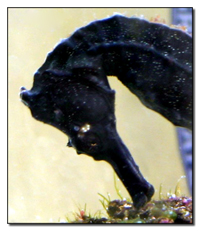 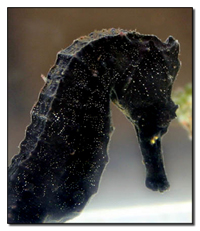 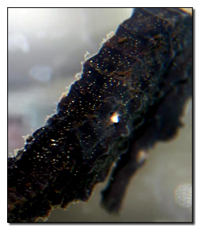
Causes/Problems
Ectoparasitic infections are most often caused by poor
quarantine and pre-treatment practices. Most wild fish,
including seahorses, routinely harbour ectoparasites
with no problems. When infected fish are put through
the stress of capture and transportation, weeks in holding
facilities without food, and the sometimes volatile
conditions that can occur in closed systems such as
aquariums, their immune systems are weakened, and the
parasites are given a chance to overtake their host.
With proper quarantine and treatment before being placed
in the display aquarium, often ectoparasites can be
eradicated with ease.
Symptoms:
- visible parasites upon examination manifested as
white spots, ulcerations, blisters, etc.
- cloudy eyes
- scratching on substrate
- wild or erratic behaviour
- signs of stress (washed out coloration, rapid breathing,
etc.)
External parasites can cause death by several means,
the most common being direct parasitism (stealing vital
nutrients from another organism's blood or other bodily
fluid), suffocation, and opening the gates for secondary
infections. External parasites can consume so much of
their host's nutrients that the host may wither and
die from malnutrition. Suffocation can be caused by
severe infestation of the gills (gill flukes). Also,
parasites often cause open sores along the body of their
host, and this, compounded with stress due to lack of
adequate nutrition, leads to internal secondary infection,
usually by a bacterium.
Treatment
The best treatment for any parasitic disease is prevention
by careful quarantine. If this is not feasible and parasites
do emerge in the display tank, treatment options are
wide. They must, however, be used in a quarantine tank.
Formalin is one of the most common
and economical chemical treatments for external protozoans
and flukes. It is best used as a dip per the instructions
of the manufacturer.
Malachite Green is an effective chemical
dye that can be used in treating most external parasites.
Use as an extended treatment in quarantine per manufacturer's
instructions.
Methylene Blue is a common medication
with seahorses. Its therapeutic properties lessen some
of the stress brought about by disease treatment. Use
it as a dip or as a long-term quarantine treatment.
Freshwater Dips are extremely effective
against gill flukes. Be sure to match the pH and temperature
of the tank's water before proceeding with a dip of
this kind.
BE VERY CAREFUL WHEN USING COPPER SULFATE
WITH SEAHORSES!! Their scaleless skin is
extremely sensitive to the abrasive properties of
it and other metals. CuSO4 levels should never be
above .25 ppm, with levels in the .19 ppm area being
ideal. Only treat under close observation as CuSO4
can suppress a seahorse's immune system, opening the
door for secondary pathogenic infections. Do not use
if other pathogens are known to be present.
|
|
Endoparasites (Internal Parasides)
Protozoans, flatworms, flukes, roundworms, tapeworms,
etc.
Causes/Problems
Internal parasitic infections are spread in much the
same way as external parasitic infections. With proper
quarantine and pre-treatment, often internal parasitic
infections can be evaded. In many cases, given appropriate
water conditions and health, seahorses can live in symbiosis
with internal parasites for many years without problems.
Additionally, endoparasites are rare with seahorses.
Symptoms:
- slow wasting/weight loss
- sometimes seen protruding from anal opening
Most commonly, these parasitic worms fix themselves
to the infected specimen's digestive tract, constantly
consuming nutrients vital to the infected specimen's
health. Unless treated, malnutrition follows, leading
to death.
Treatment
Treatment regimens for internal parasites are similar
to those for external parasites. Most commercial anti-protozoal
and anti-worm agents are effective at treating internal
parasites. They can be administered via gut-loaded ghost
shrimp or Artemia, or by injecting the medicines
into dead ghost shrimp.
Metronidazole (flagyl) is an effective
treatment against internal protozoan infections. It
must be ingested.
Niclosamide and Praziquantel are both effective against worm infections and must
be administered through food to be effective. They may
be somewhat difficult to obtain.
Freshwater Dips can be effective against
some endoparasites such as flukes, though they are generally
only effective at treating ectoparasites. |
|
Exophthalmia (Pop Eye)
Causes/Problems
Exophthalmia is not exactly a disease, but a stress
symptom that can be brought about by many ailments.
Most often, however, its cause stems from bacterial
infection. Pop Eye can also be caused by parasitic or
fungal infections. If the condition appears in only
one eye, it may have been caused by physical injury
such as being scratched by a rock.
Symptoms:
- severe protrusion of the eye from the orbital cavity
If left untreated, exophthalmia can cause damage to
the infected eye(s). It can also be a sign of more serious
problems that themselves can cause death.
Treatment
There is no direct treatment for exophthalmia. Often
all that can be done is eliminating the causative agent.
Maintaining stable water conditions and feeding food
medicated with an antibacterial (done in quarantine)
may prove effective. Large water changes and correction
of obvious water quality problems may also be useful
in treating this condition. |
|
External Gas Bubble Disease
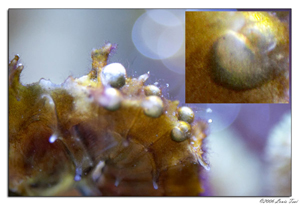 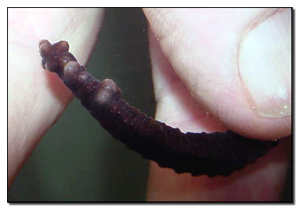
Causes/Problems
This condition is thought to be caused by either bacterial
infection (in which case waste gases produced by the
infecting bacteria become trapped under the skin) or
by gas super-saturation of the water in which the seahorses
reside. Gas super-saturation causes problems similar
to the bends, which affects SCUBA divers. The situation,
in which gas levels in the water are much higher than
normally possible (caused by limited areas for gas escape),
causes gas bubbles to form where possible. Because the
pressure inside of a seahorse is lower than the pressure
of gas super-saturated water, the gas bubbles emerge
directly under the skin of the affected seahorse.
Symptoms
- subcutaneous (under the skin) air bubbles that may
occur anywhere on the head, body, or prehensile tail
- buoyancy and movement complications
The bubbles can cause stress on a seahorse as problems
with buoyancy and movement arise. If left unchecked,
the disease may eventually cause death in the infected
specimen due to this stress. The appearance of external
gas bubble disease can be a sign of more serious problems.
Treatment
Diamox baths are considered to be
the best treatment.
As a temporary treatment, air
bubbles may be lanced with a sterile needle to provide
some relief for an infected seahorse. To perform
this lancing, first sterilize the needle with either
isopropyl alcohol or by waving it through a flame.
If the flame method of sterilization is used, be
sure to cool the needle completely to avoid burning
your seahorse. Then insert the needle into the air
bubble parallel to the seahorse's body. The bubbles
may then be gently compressed to evacuate any air
inside. As a precaution, it may be wise to place
the treated horse's) in quarantine with an antibacterial
agent for one or two days to allow time for the
puncture to heal.
|
The above italicised treatment
is currently under review, as it is not currently thought
to be a good idea to puncture the seahorses skin.
Unless the cause of EGBD is not rectified, it will
often return within days or weeks. Changes to the tank
setup may have to be made if the condition does indeed
return. First, try a series of large water changes.
Often bad water conditions can trigger external gas
bubble disease. Secondly, a power head can be aimed
at the surface of the water, providing surface agitation
and gas exchange. If the condition continues to recur,
the tank setup itself may need to be revaluated for
parameters including height, etc., that can affect external
gas bubble disease. |
| |
Flesh-Erosion
Disease
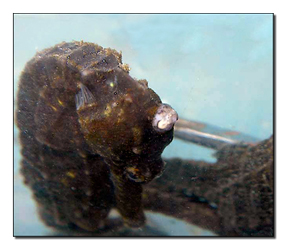 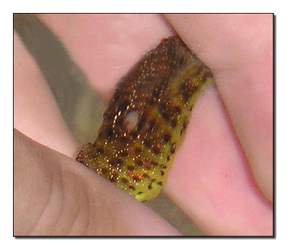
Causes/Problems
Raging bacterial infections such as those associated
with the consumption of seahorse flesh are spread through
contamination of uninfected seahorses with infected
seahorses. Often the causative agent, the bacterial
genus Vibrio in most cases of flesh erosion,
will lay dormant unless given the opportunity to become
active. This opportunity usually coincides with a deterioration
of water quality. With proper quarantine and treatment,
however, this disease can be avoided altogether. |
Symptoms:
- erosion/sloughing of the flesh
- cloudy eyes
- rapid breathing
- swelling
Infections of this type, almost always bacterial, can
cause an awful death for seahorses. The disease manifests
itself by consuming the seahorse's flesh all the way
to the bone, causing irreparable damage that leads to
death.
Treatment
The best treatment for bacterial infections is always
preventative quarantine, but if an infection is present
in the tank, hospitalization of the infected specimens
and treatment with antibacterial agents is the only
solution.
Combination drugs such as Furan II and Paragon II are often most effective
at combating bacterial infections. These drugs cover
both spectrums of bacteria (gram+ and gram-), and can
usually halt progression within days. Use the marine
dose per the manufacturer's instructions. Drugs from
the tetracycline family may also be
of some help, specifically doxycycline and oxytetracycline, though they may
be somewhat difficult to get a hold of. Topical treatments
such as neomycin (Neosporin)
and iodine or formalin solutions (1 cup water to 15 drops of either or both)
used three to four times daily on the affected area
can also help in controlling the progression of the
disease.
Advances are being made in the way of creating seahorse
vaccines that could possibly eliminate the occurrence
of infections of this type. The most likely causative
agent in most cases is Vibrio sp., a bacterium
with high resistance to most drugs available to hobbyists
and institutions alike.
If the disease returns, the infected horses will need
to be requarantined, the display tank may have to be
scrubbed down, and all equipment may have to be sterilized
with bleach. Be careful not to allow any sterilization
chemicals to make their way back into the aquarium as
this will destroy the essential denitrifying bacteria
present in the aquarium's bacterial filter bed. If this
does not arrest the occurrence of flesh-eating bacteria,
the seahorses may have to be relocated to a new display
system. |
|
Internal Gas Bubble Disease
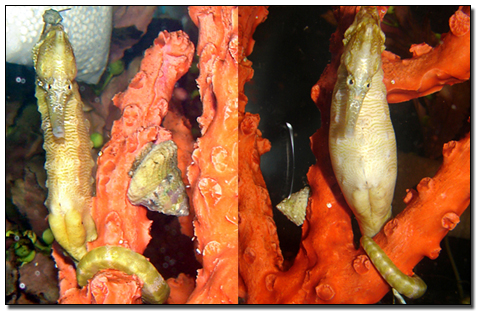
Causes/Problems
The possible causes of internal gas bubble disease
are a constant topic of conversation (and argument).
It is thought to be cause by some of the same
factors as external gas bubble disease—gas
super-saturation or bacterial infection. Unfortunately,
if given the opportunity to progress to actual
total-body bloating, it is often too late for
the infected seahorse. |
|
Symptoms
- severe bloating of the entire body
- external gas bubbles
- exophthalmia
- buoyancy and movement complications
The most grave problems with internal gas bubble disease
lie in its crippling effects on the infected specimen's
internal organs. If allowed to progress, often the organs
are damaged beyond recovering, leading to severe organ
failure.
Treatment
Treatment of internal gas bubble disease is often difficult
and not practical. There are currently only two proven
ways of treating this medical condition.
Decompression involves placing the
afflicted seahorse in a decompression chamber that is
at least three times deeper than the height of the tank
in which it resides regularly. The seahorse must be
kept on the bottom of this chamber, and it must remain
there for hours, at least. This treatment is often not
possible as resources needed are generally not available
to hobbyists. Additionally, the organs are often too
damaged for this treatment to be successful.
Perhaps more promising is the use of a drug called acetazolamide. This drug, called Diamox in the medicinal trade, is very successful at treating
all gas-related seahorse disorders. To use it, a solution
of 1/8th of a 250 mg tablet should be dissolved in one
cup of water. The solution should then be injected into
ghost shrimp, which are then frozen. The prepared shrimp
are then fed to the affected seahorse at a rate of two
per day for four days to complete treatment. This treatment
must be administered very early to work, but if done
correctly, success rates can be high. |
|
Pouch Emphysema
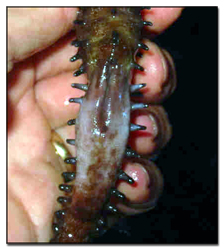 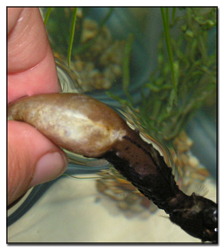
Causes/Problems
As with internal gas bubble disease, the causes of
pouch emphysema are highly disputed within the seahorse
hobby. It was once thought that the condition could
be traced to embryonic that is not expelled during labor
rotting inside of the pouch. This decomposition process
would yield gasses that inflate the pouch. Do to the
fact that the condition often shows up in 'virgin' male
seahorses, however, other theorized causes may be more
reasonable. These include micro-bubbles in the water
column that can collect in the pouch during mating rituals
and bacterial infections, the waste products of which
include gases that can fill the pouch. This type of
infection is often attributed to recurring pouch emphysema.
More recent research, however, has traced a more likely
cause to a biological process known as the hydration
of CO2(g), carbon dioxide gas, to H2CO3(aq), carbonic
acid. This process occurs on a cellular level. An enzyme
known as carbonic anhydrase catalyzes the hydration
of CO2(g) with H2O(l) to H2CO3(aq), carbonic acid. When
this reaction is disturbed, however, CO2(g) is not converted
into H2CO3(aq), thus leading to a buildup of carbon
dioxide gas in the pouch tissues. The exact cause of
the disruption of this process, however, remains unknown.
Symptoms:
- grossly bloated/swollen pouch
- severely hindered locomotion and buoyancy problems
This malady only infects male seahorses as females
do not have pouches. If not treated, the condition will
cause the infected male to have limited locomotion and
severe buoyancy problems that can lead to stress and
secondary infection. Cessation of appetite normally
follows, and the horse may starve. Other problems include
the possibility of the infected horse becoming stranded
on a filter intake, overflow box, or similar piece of
equipment. Prolonged experiences like this can cause
internal injury and stress.
Treatment
For immediate relief of this malady, the pouch of an
infected seahorse can first be evacuated per the instructions
of Seahorse.org's
Pouch Evacuation article.
If the condition returns, a pouch flush preferably
using acetazolamide must be administered.
To perform this treatment, you will need the following:
- one 250mg acetazolamide tablet
- a 1/2cc diabetic syringe with needle
When you have obtained the needed supplies from either
your physician or vet, you will first need to remove
the sharp tip of the needle so that the pouch is not
punctured. This can be done easily by cutting just above
the tip with a sharp pair of scissors. Once the syringe
is ready, you will need to prepare a solution of the acetazolamide by dissolving 1/4th of
the tablet in 2 cups seawater. The tablet will need
to be crushed first to ensure that it dissolves completely.
When the solution and syringe are prepared, relocate
the seahorses to a container filled with its own tank
water. Gently hold the seahorse in one hand while inserting
the syringe into the pouch with the other. Be very careful
to not puncture the pouch. There may be some resistance
when inserting the syringe, but be patient as it will
eventually slide in. Once the needle is in, depress
the syringe completely to release all of the solution
into the pouch. Some may spill out. Now the horse can
be returned to his tank. Repeat this treatment the next
two days for a total of three consecutive treatments.
With any luck, the pouch emphysema will not return. |
|
Snout Rot
|
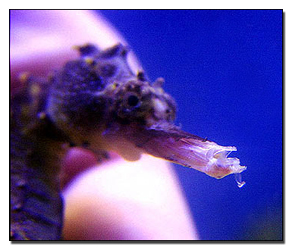 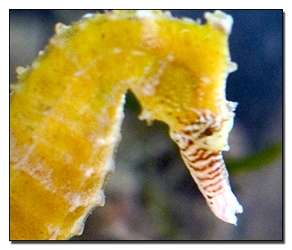
Causes/Problems
Similar to and likey caused by the same pathogen as flesh-eating bacteria, Vibrio spp., snout rot can often be controlled with pre-treatment before the seahorse is released into the display aquarium. The disease may be cause either by fungal infection (in which case the snout will be pinkish) or bacterial infection (in which case the snout will be white). If left untreated, the disease will often appear when water quality worsens or during prolonged periods of stress.
Symptoms:
- discoloration of the snout
- swelling of the snout
- lockjaw
- loss of appetite
- tissue erosion on the snout
When first infected, seahorses generally are not bothered by snout rot. As this grave disease progresses, however, the mouthparts of an infected seahorse may become so destroyed that eating is no longer possible. This causes inevitable death.
|
Treatment
As with flesh-eating bacteria, the best treatment for snout rot is preventative quarantine before release into the display tank. The disease will not always manifest itself immediately, however. Luckily, treatment is not very difficult.
The best treatment is by use of combination medications such as Paragon II in a hospital tank. This medication covers gram+ bacteria, gram- bacteria, and fungus. It has ingredients that can eliminate or stop the progression of snout rot within days. In severe cases, a double treatment may be necessary. In any case, follow the directions of the manufacturer. Topical treatments such as neomycin (Neosporin) and iodine or formalin solutions (1 cup water to 15 drops of either or both) used three to four times daily on the affected area can also help in controlling the progression of the disease.
If after treatment the disease returns, the infected horses will need to be requarantined, the display tank may have to be scrubbed down, and all equipment may have to be sterilized with bleach. Be careful not to allow any sterilization chemicals to make their way back into the aquarium as this will destroy the essential denitrifying bacteria present in the aquarium's bacterial filter bed. If this does not arrest the occurrence of snout rot, the seahorses may have to be relocated to a new display system. This is often, however, not the case. |
|
| |
|
